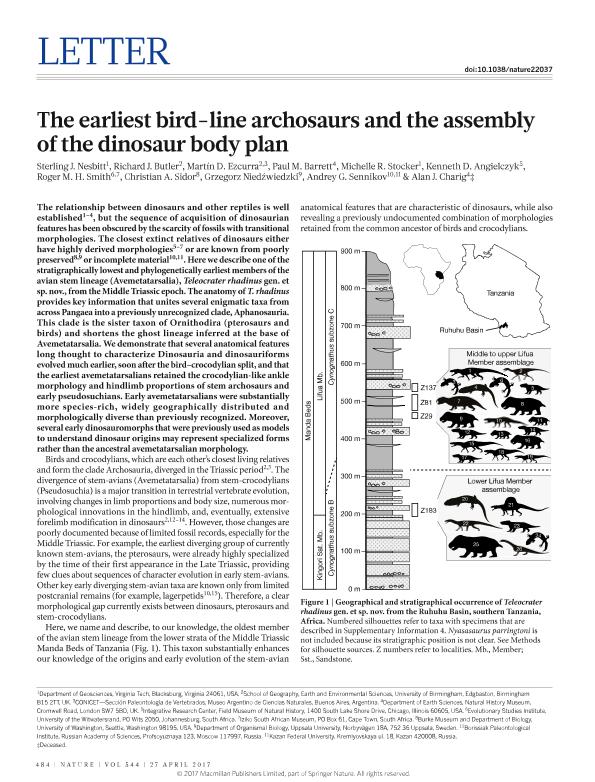Artículo
The earliest bird-line archosaurs and the assembly of the dinosaur body plan
Nesbitt, Sterling J.; Butler, Richard J.; Ezcurra, Martin Daniel ; Barrett, Paul M.; Stocker, Michelle R.; Angielczyk, Kenneth D.; Smith, Roger M. H.; Sidor, Christian A.; Niedźwiedzki, Grzegorz; Sennikov, Andrey G.; Charig, Alan J.
; Barrett, Paul M.; Stocker, Michelle R.; Angielczyk, Kenneth D.; Smith, Roger M. H.; Sidor, Christian A.; Niedźwiedzki, Grzegorz; Sennikov, Andrey G.; Charig, Alan J.
 ; Barrett, Paul M.; Stocker, Michelle R.; Angielczyk, Kenneth D.; Smith, Roger M. H.; Sidor, Christian A.; Niedźwiedzki, Grzegorz; Sennikov, Andrey G.; Charig, Alan J.
; Barrett, Paul M.; Stocker, Michelle R.; Angielczyk, Kenneth D.; Smith, Roger M. H.; Sidor, Christian A.; Niedźwiedzki, Grzegorz; Sennikov, Andrey G.; Charig, Alan J.
Fecha de publicación:
04/2017
Editorial:
Nature Publishing Group
Revista:
Nature
ISSN:
0028-0836
e-ISSN:
1476-4687
Idioma:
Inglés
Tipo de recurso:
Artículo publicado
Clasificación temática:
Resumen
The relationship between dinosaurs and other reptiles is well established, but the sequence of acquisition of dinosaurian features has been obscured by the scarcity of fossils with transitional morphologies. The closest extinct relatives of dinosaurs either have highly derived morphologies or are known from poorly preserved or incomplete material. Here we describe one of the stratigraphically lowest and phylogenetically earliest members of the avian stem lineage (Avemetatarsalia), Teleocrater rhadinus gen. et sp. nov., from the Middle Triassic epoch. The anatomy of T. rhadinus provides key information that unites several enigmatic taxa from across Pangaea into a previously unrecognized clade, Aphanosauria. This clade is the sister taxon of Ornithodira (pterosaurs and birds) and shortens the ghost lineage inferred at the base of Avemetatarsalia. We demonstrate that several anatomical features long thought to characterize Dinosauria and dinosauriforms evolved much earlier, soon after the bird-crocodylian split, and that the earliest avemetatarsalians retained the crocodylian-like ankle morphology and hindlimb proportions of stem archosaurs and early pseudosuchians. Early avemetatarsalians were substantially more species-rich, widely geographically distributed and morphologically diverse than previously recognized. Moreover, several early dinosauromorphs that were previously used as models to understand dinosaur origins may represent specialized forms rather than the ancestral avemetatarsalian morphology.
Palabras clave:
Palaeontology
,
Taxonomy
Archivos asociados
Licencia
Identificadores
Colecciones
Articulos(MACNBR)
Articulos de MUSEO ARG.DE CS.NAT "BERNARDINO RIVADAVIA"
Articulos de MUSEO ARG.DE CS.NAT "BERNARDINO RIVADAVIA"
Citación
Nesbitt, Sterling J.; Butler, Richard J.; Ezcurra, Martin Daniel; Barrett, Paul M.; Stocker, Michelle R.; et al.; The earliest bird-line archosaurs and the assembly of the dinosaur body plan; Nature Publishing Group; Nature; 544; 7651; 4-2017; 484-487
Compartir
Altmétricas



